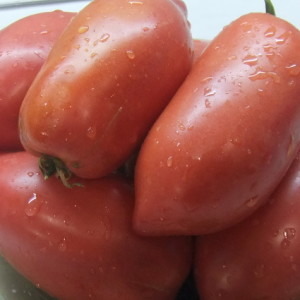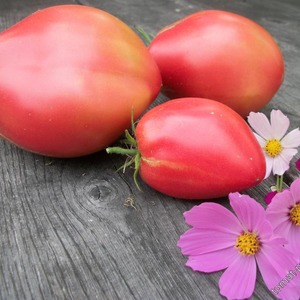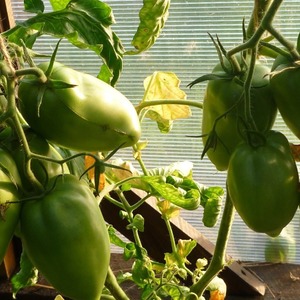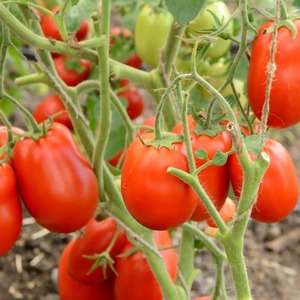Delicious, sweet and juicy tomatoes "Podsinskoe miracle" - a gift from Minusinsk amateur breeders
The tomato culture Podsinskoe Miracle was bred by amateur breeders from the city of Minusinsk, Krasnoyarsk Territory. The initial harsh climatic conditions gave the variety a valuable feature - the ability to successfully take root in any region of our country.
The culture does not require special attention and care; it responds to timely feeding and regular watering with large fruits of a bright red-pink color. An interesting plum-shaped form of vegetables looks unusual in whole-fruit canning: pink-scarlet cream tomatoes will be an adornment for both festive and everyday tables.
The content of the article
Characteristics and description of the variety
To be precise, the variety was created in the village of Podsineya, 8 km from Minusinsk. The name of the village is reflected in the name of the tomato variety.
The shrub belongs to the indeterminate type, which means unlimited height, which reaches 1.7-2.0 m. For this reason, the culture received a second name - Podsinskaya Liana. This height requires a mandatory garter.
Sprawling bushes. Leaves are ordinary, light green. Of all the varieties of tomatoes, this crop has the lightest green color. Stealing is a must. The plant develops into 1-2 stems.
The species is late ripening, from the moment of sowing the seeds to full ripening it takes about 4 months. Harvesting occurs in late August - early September.
The yield is high, which is considered the main advantage of the culture. At least 6 kg of vegetables are harvested from one bush, 5-6 fruits are tied on one branch.
Fruits are large, weighing 400 g or more. The color is bright red-pink, sometimes crimson. The taste is sweet with slightly noticeable sourness. There are few seeds. The shape is plum-shaped, elongated. The skin of the fruit is smooth, has a high density, therefore, when ripe, vegetables do not crack.

They are universal in culinary use: they are consumed fresh, conservation, for processing into tomato products.
Ripe vegetables are subject to long-term storage and perfectly withstand long-term transportation.
Selected tomatoes are excellent for growing in regions with unfavorable climatic conditions. They are able to withstand weather changes for 1 day.
Photo of ripe tomato Podsinskoe Miracle conveys fruit color and unusual appearance well.
How to grow seedlings
Seedlings begin to grow 60 days before transplanting them into the ground. In terms of sowing seeds, it falls in mid-March - early April. First, the seeds are disinfected by soaking in a weak solution of potassium permanganate for 30 minutes. Then the dried seeds are left in a growth promoter for 10 hours. This significantly increases germination, besides, the sprouts will be less susceptible to diseases.
The soil is made from a mixture of garden soil with old peat or humus. A light nutritious soil is suitable for this variety, therefore, a small amount of washed river sand is added to the soil for ease.
Any container is suitable for sowing seeds, at the bottom of which drainage is poured in the form of crushed eggshell or small pebbles. The soil is poured on top of the drainage and the grains are laid in grooves 2 cm deep.
After sowing, the ground is leveled from above, watered from a watering can, cover the containers with foil and put them in a dark and warm room where the temperature does not drop below 22 ° C. In this case, it is necessary to control the condition of the soil and to water if necessary.
reference... For greater germination, seeds are germinated for several days in damp gauze.
When the first shoots appear, the seedlings are rearranged in a sunny place, but not in direct sunlight. To extend daylight hours, artificial lighting lamps are used. Tomato needs a long day of light, at least 18 hours.
A pick is carried out when two true leaves appear, planting the sprouts in individual containers. At this moment, the first feeding with full complex fertilizer is needed.
Tempering is carried out 2 weeks before planting the seedlings in the ground. Hardening of seedlings is especially important in the northern regions, otherwise the sprouts will adapt for a long time to the main growing area. Seedlings are taken out daily. Start at 2 o'clock, gradually increasing to 1 day. At the same time, the night temperature in the room where the seedlings are brought in at night drops to + 13 ° C.
reference... You can buy tomato seeds Podsinskoe Chudo in most specialized stores.
How to grow tomatoes
Young tomatoes are planted in the ground no earlier than the second half of May, when the air temperature does not drop below + 14 ° C. Before planting, the soil is mixed with manure or bird droppings. Weak bushes are fed with complexes of nitrogen fertilizers before transplanting.
reference... Since nitrogen fertilization affects growth, tall plants do not need to be fed with them. Fertilize only underdeveloped seedlings.
For 1 sq. m, no more than 3 seedlings are planted, since thickening leads to a decrease in yield. The permissible distance between them is 50-60 cm.
The transplanted bushes are watered with warm, settled water under the root and covered with foil. Water the second time no earlier than 6 days later. After watering, the soil is loosened and weeds and roots are removed. To keep the soil moist longer, the beds are mulched with straw. But do not forget that waterlogging of the soil leads to cracking of the fruit and a decrease in taste.
Top dressing is carried out three times per season: during flowering, fruit setting and ripening. Mineral complexes or organics are suitable as fertilizers. Organic matter - mullein infusion - is carefully diluted with water so as not to burn the root system. Also, the culture responds well to drip irrigation.
Active plant growth and branching of bushes require mandatory garters... For this, wooden stakes or metal rods are installed next to each bush.
Another prerequisite for leaving is pinching. Remove all stepchildren, forming a plant in 1 or 2 stems. In high bushes, pinch the top. This simple method helps to avoid further growth of tomatoes.
Diseases and pests
There is a certain resistance to the main diseases of the Solanaceae family. But in greenhouse conditions, seedlings can be affected by apical, basal and gray rot. In the fight against mold, disinfection of the soil before planting tomatoes and systematic airing of the greenhouse are effective. Treatment of plants with Fitosporin and other non-toxic biological products will also help get rid of mold.
To keep the seedlings from phytophthora, plantings are treated with copper-containing preparations. If, nevertheless, late blight dominated your beds, the affected parts of the plants should be cut off and burned.
Pests from the insect world is another attack on tomato crops. Medvedka, aphids, spider mites, slugs, Colorado potato beetle can cause considerable damage to culture. In the fight against them, both chemical and folk methods are used. But do not forget that the use of chemistry is possible only before the flowering period. But folk methods are good throughout the growing season. They are no less effective and, unlike insecticides, cause less harm to crop development.
Medvedka - a serious destroyer of the root system. It is difficult to spot it as it moves underground.Fragrant marigolds planted next to tomatoes will help scare her away. She also dislikes the smell of garlic and fish. Therefore, if you bury fish heads and chopped cloves of garlic in the beds, the bear will bypass them.
Colorado potato beetle and slugs harvested by handby regularly examining the bushes for pests. Treatment of bushes with soapy water saves from aphids. The main thing is that it does not fall on the ground. Onion peel decoction helps from other pests that harm vegetable crops. Also, the stems are sprayed with an aqueous solution of ammonia.
The nuances of growing in a greenhouse and in the open field
Despite the fact that the variety is recommended for breeding throughout the territory of our country, the conditions for its growth are not the same everywhere. On open beds, the highest fruiting rate is in Krasnodar or Crimea. In Siberia and temperate latitudes, it will please with a rich harvest, being under the film.
The advantages of open ground are that the variety is less prone to growth in height and width here. But on the street, attacks from insects most often occur.
In a greenhouse, on the contrary, the probability of attack by pests is least of all, but here the threat of mold damage remains.
Regardless of where it grows, proper care will help keep your culture healthy, which is essential for full growth and development.
Harvesting and application of the crop
From late August to early September, harvesting of late-ripening tomatoes begins. The long waiting time is compensated by the large number of ripe tomatoes. Fruiting is prolonged, continues until the onset of the first frost.
Vegetables are used fresh. They are suitable for winter preparations: salting, twisting, pickling. They do not lose their taste in tomato products: juices, ketchups, mashed potatoes, adjika, lecho. Well suited for whole fruit canning due to their dense skin.
The tomato is subject to long-term storage, withstands long-term transportation, perfectly preserving its presentation and gastronomic qualities.
The presentable type of vegetables makes it possible to grow a variety for sale, fully justifying the initial costs.
Advantages and disadvantages of the variety
The variety has a large number of significant positive qualities that can interest lovers of late tomatoes:
- survival in any region;
- the ability to tolerate drought and changes in weather conditions during the day;
- long-term fruiting;
- high yield rate;
- unpretentious care;
- resistance to major diseases;
- large fruits;
- excellent taste;
- unusual shape;
- versatility in cooking;
- long shelf life of ripe vegetables;
- excellent transportability.
Culture has disadvantages, but compared to the advantages, they are insignificant:
- garter required;
- pinching and pinching is required;
- cracking of fruits from waterlogging.
Farmers reviews
Everyone who grew late-ripening tomatoes in their beds speaks of them as high-class products. Sometimes from gardeners you can hear a different name - tomato Podosinovskoe Miracle. It remains only to guess the reason for its occurrence: whether it is in honor of the late ripening of the fruits, in the fall, or whether this is due to the little-known name of the village where the variety was bred.
The collected reviews about the tomato Podsinskoe Miracle belong to completely different regions, with a sharply different climate and the length of the day and night. However, the variety has proven itself only on the positive side, so different opinions speak in favor of this vegetable crop.
Tamara, Chelyabinsk:“I grew a tomato in a greenhouse, there is no other way for us. The variety was not sick. The fruits are large, tasty, both fresh and salted. I chose smaller tomatoes only for salting. "
Nadezhda, Tatarstan: “I planted it in open beds. The fruits, unfortunately, were struck by the top rot. I watered and sprayed them with calcium nitrate. Most of the harvest was saved. The vegetables are delicious, beautiful.I'll try to plant it again. "
Elena, Kharkov, Ukraine: “The fruits were born in the form of elongated pink cream. The taste is sweet, delicate, melt in the mouth. A bush of medium strength, led in 3 stems. During the season the tomatoes were not sick. "
Conclusion
Thanks to amateur agronomists, the world of tomatoes has been replenished with the selection species Podsinskoye Miracle. Its incontrovertible cold resistance allows many regions deprived of heat not only to grow unique vegetables, but also to transport them for sale anywhere.
It is not for nothing that the word “miracle” appears in the name of the variety, because, as if by magic, by the beginning of autumn the land plots are decorated with elegant beds with plum tomatoes. And from you to obtain such a miracle, all that is required is that several dressings and infrequent watering.